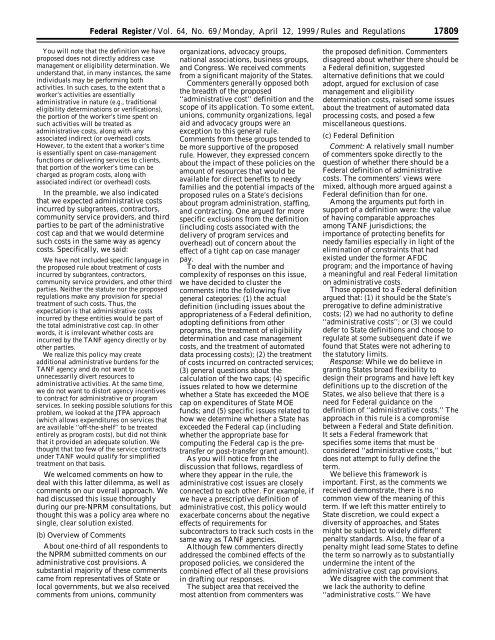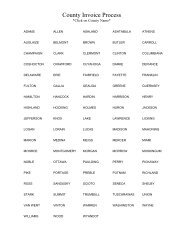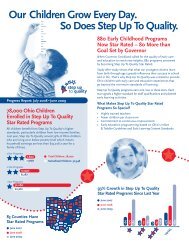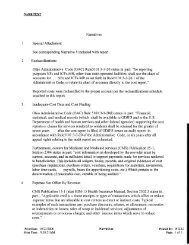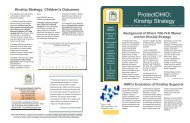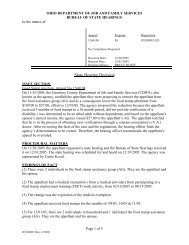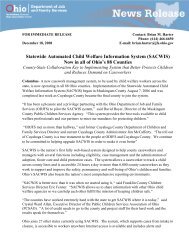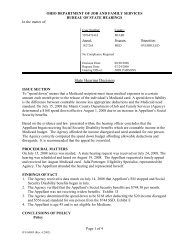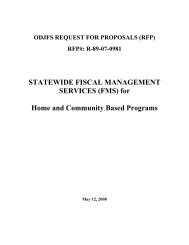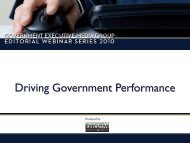Final TANF Rule as published in the Federal Register 4/12/1999
Final TANF Rule as published in the Federal Register 4/12/1999
Final TANF Rule as published in the Federal Register 4/12/1999
Create successful ePaper yourself
Turn your PDF publications into a flip-book with our unique Google optimized e-Paper software.
<strong>Federal</strong> <strong>Register</strong> / Vol. 64, No. 69 / Monday, April <strong>12</strong>, <strong>1999</strong> / <strong>Rule</strong>s and Regulations<br />
You will note that <strong>the</strong> def<strong>in</strong>ition we have<br />
proposed does not directly address c<strong>as</strong>e<br />
management or eligibility determ<strong>in</strong>ation. We<br />
understand that, <strong>in</strong> many <strong>in</strong>stances, <strong>the</strong> same<br />
<strong>in</strong>dividuals may be perform<strong>in</strong>g both<br />
activities. In such c<strong>as</strong>es, to <strong>the</strong> extent that a<br />
worker’s activities are essentially<br />
adm<strong>in</strong>istrative <strong>in</strong> nature (e.g., traditional<br />
eligibility determ<strong>in</strong>ations or verifications),<br />
<strong>the</strong> portion of <strong>the</strong> worker’s time spent on<br />
such activities will be treated <strong>as</strong><br />
adm<strong>in</strong>istrative costs, along with any<br />
<strong>as</strong>sociated <strong>in</strong>direct (or overhead) costs.<br />
However, to <strong>the</strong> extent that a worker’s time<br />
is essentially spent on c<strong>as</strong>e-management<br />
functions or deliver<strong>in</strong>g services to clients,<br />
that portion of <strong>the</strong> worker’s time can be<br />
charged <strong>as</strong> program costs, along with<br />
<strong>as</strong>sociated <strong>in</strong>direct (or overhead) costs.<br />
In <strong>the</strong> preamble, we also <strong>in</strong>dicated<br />
that we expected adm<strong>in</strong>istrative costs<br />
<strong>in</strong>curred by subgrantees, contractors,<br />
community service providers, and third<br />
parties to be part of <strong>the</strong> adm<strong>in</strong>istrative<br />
cost cap and that we would determ<strong>in</strong>e<br />
such costs <strong>in</strong> <strong>the</strong> same way <strong>as</strong> agency<br />
costs. Specifically, we said:<br />
We have not <strong>in</strong>cluded specific language <strong>in</strong><br />
<strong>the</strong> proposed rule about treatment of costs<br />
<strong>in</strong>curred by subgrantees, contractors,<br />
community service providers, and o<strong>the</strong>r third<br />
parties. Nei<strong>the</strong>r <strong>the</strong> statute nor <strong>the</strong> proposed<br />
regulations make any provision for special<br />
treatment of such costs. Thus, <strong>the</strong><br />
expectation is that adm<strong>in</strong>istrative costs<br />
<strong>in</strong>curred by <strong>the</strong>se entities would be part of<br />
<strong>the</strong> total adm<strong>in</strong>istrative cost cap. In o<strong>the</strong>r<br />
words, it is irrelevant whe<strong>the</strong>r costs are<br />
<strong>in</strong>curred by <strong>the</strong> <strong>TANF</strong> agency directly or by<br />
o<strong>the</strong>r parties.<br />
We realize this policy may create<br />
additional adm<strong>in</strong>istrative burdens for <strong>the</strong><br />
<strong>TANF</strong> agency and do not want to<br />
unnecessarily divert resources to<br />
adm<strong>in</strong>istrative activities. At <strong>the</strong> same time,<br />
we do not want to distort agency <strong>in</strong>centives<br />
to contract for adm<strong>in</strong>istrative or program<br />
services. In seek<strong>in</strong>g possible solutions for this<br />
problem, we looked at <strong>the</strong> JTPA approach<br />
(which allows expenditures on services that<br />
are available ‘‘off-<strong>the</strong>-shelf’’ to be treated<br />
entirely <strong>as</strong> program costs), but did not th<strong>in</strong>k<br />
that it provided an adequate solution. We<br />
thought that too few of <strong>the</strong> service contracts<br />
under <strong>TANF</strong> would qualify for simplified<br />
treatment on that b<strong>as</strong>is.<br />
We welcomed comments on how to<br />
deal with this latter dilemma, <strong>as</strong> well <strong>as</strong><br />
comments on our overall approach. We<br />
had discussed this issue thoroughly<br />
dur<strong>in</strong>g our pre-NPRM consultations, but<br />
thought this w<strong>as</strong> a policy area where no<br />
s<strong>in</strong>gle, clear solution existed.<br />
(b) Overview of Comments<br />
About one-third of all respondents to<br />
<strong>the</strong> NPRM submitted comments on our<br />
adm<strong>in</strong>istrative cost provisions. A<br />
substantial majority of <strong>the</strong>se comments<br />
came from representatives of State or<br />
local governments, but we also received<br />
comments from unions, community<br />
organizations, advocacy groups,<br />
national <strong>as</strong>sociations, bus<strong>in</strong>ess groups,<br />
and Congress. We received comments<br />
from a significant majority of <strong>the</strong> States.<br />
Commenters generally opposed both<br />
<strong>the</strong> breadth of <strong>the</strong> proposed<br />
‘‘adm<strong>in</strong>istrative cost’’ def<strong>in</strong>ition and <strong>the</strong><br />
scope of its application. To some extent,<br />
unions, community organizations, legal<br />
aid and advocacy groups were an<br />
exception to this general rule.<br />
Comments from <strong>the</strong>se groups tended to<br />
be more supportive of <strong>the</strong> proposed<br />
rule. However, <strong>the</strong>y expressed concern<br />
about <strong>the</strong> impact of <strong>the</strong>se policies on <strong>the</strong><br />
amount of resources that would be<br />
available for direct benefits to needy<br />
families and <strong>the</strong> potential impacts of <strong>the</strong><br />
proposed rules on a State’s decisions<br />
about program adm<strong>in</strong>istration, staff<strong>in</strong>g,<br />
and contract<strong>in</strong>g. One argued for more<br />
specific exclusions from <strong>the</strong> def<strong>in</strong>ition<br />
(<strong>in</strong>clud<strong>in</strong>g costs <strong>as</strong>sociated with <strong>the</strong><br />
delivery of program services and<br />
overhead) out of concern about <strong>the</strong><br />
effect of a tight cap on c<strong>as</strong>e manager<br />
pay.<br />
To deal with <strong>the</strong> number and<br />
complexity of responses on this issue,<br />
we have decided to cluster <strong>the</strong><br />
comments <strong>in</strong>to <strong>the</strong> follow<strong>in</strong>g five<br />
general categories: (1) <strong>the</strong> actual<br />
def<strong>in</strong>ition (<strong>in</strong>clud<strong>in</strong>g issues about <strong>the</strong><br />
appropriateness of a <strong>Federal</strong> def<strong>in</strong>ition,<br />
adopt<strong>in</strong>g def<strong>in</strong>itions from o<strong>the</strong>r<br />
programs, <strong>the</strong> treatment of eligibility<br />
determ<strong>in</strong>ation and c<strong>as</strong>e management<br />
costs, and <strong>the</strong> treatment of automated<br />
data process<strong>in</strong>g costs); (2) <strong>the</strong> treatment<br />
of costs <strong>in</strong>curred on contracted services;<br />
(3) general questions about <strong>the</strong><br />
calculation of <strong>the</strong> two caps; (4) specific<br />
issues related to how we determ<strong>in</strong>e<br />
whe<strong>the</strong>r a State h<strong>as</strong> exceeded <strong>the</strong> MOE<br />
cap on expenditures of State MOE<br />
funds; and (5) specific issues related to<br />
how we determ<strong>in</strong>e whe<strong>the</strong>r a State h<strong>as</strong><br />
exceeded <strong>the</strong> <strong>Federal</strong> cap (<strong>in</strong>clud<strong>in</strong>g<br />
whe<strong>the</strong>r <strong>the</strong> appropriate b<strong>as</strong>e for<br />
comput<strong>in</strong>g <strong>the</strong> <strong>Federal</strong> cap is <strong>the</strong> pretransfer<br />
or post-transfer grant amount).<br />
As you will notice from <strong>the</strong><br />
discussion that follows, regardless of<br />
where <strong>the</strong>y appear <strong>in</strong> <strong>the</strong> rule, <strong>the</strong><br />
adm<strong>in</strong>istrative cost issues are closely<br />
connected to each o<strong>the</strong>r. For example, if<br />
we have a prescriptive def<strong>in</strong>ition of<br />
adm<strong>in</strong>istrative cost, this policy would<br />
exacerbate concerns about <strong>the</strong> negative<br />
effects of requirements for<br />
subcontractors to track such costs <strong>in</strong> <strong>the</strong><br />
same way <strong>as</strong> <strong>TANF</strong> agencies.<br />
Although few commenters directly<br />
addressed <strong>the</strong> comb<strong>in</strong>ed effects of <strong>the</strong><br />
proposed policies, we considered <strong>the</strong><br />
comb<strong>in</strong>ed effect of all <strong>the</strong>se provisions<br />
<strong>in</strong> draft<strong>in</strong>g our responses.<br />
The subject area that received <strong>the</strong><br />
most attention from commenters w<strong>as</strong><br />
17809<br />
<strong>the</strong> proposed def<strong>in</strong>ition. Commenters<br />
disagreed about whe<strong>the</strong>r <strong>the</strong>re should be<br />
a <strong>Federal</strong> def<strong>in</strong>ition, suggested<br />
alternative def<strong>in</strong>itions that we could<br />
adopt, argued for exclusion of c<strong>as</strong>e<br />
management and eligibility<br />
determ<strong>in</strong>ation costs, raised some issues<br />
about <strong>the</strong> treatment of automated data<br />
process<strong>in</strong>g costs, and posed a few<br />
miscellaneous questions.<br />
(c) <strong>Federal</strong> Def<strong>in</strong>ition<br />
Comment: A relatively small number<br />
of commenters spoke directly to <strong>the</strong><br />
question of whe<strong>the</strong>r <strong>the</strong>re should be a<br />
<strong>Federal</strong> def<strong>in</strong>ition of adm<strong>in</strong>istrative<br />
costs. The commenters’ views were<br />
mixed, although more argued aga<strong>in</strong>st a<br />
<strong>Federal</strong> def<strong>in</strong>ition than for one.<br />
Among <strong>the</strong> arguments put forth <strong>in</strong><br />
support of a def<strong>in</strong>ition were: <strong>the</strong> value<br />
of hav<strong>in</strong>g comparable approaches<br />
among <strong>TANF</strong> jurisdictions; <strong>the</strong><br />
importance of protect<strong>in</strong>g benefits for<br />
needy families especially <strong>in</strong> light of <strong>the</strong><br />
elim<strong>in</strong>ation of constra<strong>in</strong>ts that had<br />
existed under <strong>the</strong> former AFDC<br />
program; and <strong>the</strong> importance of hav<strong>in</strong>g<br />
a mean<strong>in</strong>gful and real <strong>Federal</strong> limitation<br />
on adm<strong>in</strong>istrative costs.<br />
Those opposed to a <strong>Federal</strong> def<strong>in</strong>ition<br />
argued that: (1) it should be <strong>the</strong> State’s<br />
prerogative to def<strong>in</strong>e adm<strong>in</strong>istrative<br />
costs; (2) we had no authority to def<strong>in</strong>e<br />
‘‘adm<strong>in</strong>istrative costs’’; or (3) we could<br />
defer to State def<strong>in</strong>itions and choose to<br />
regulate at some subsequent date if we<br />
found that States were not adher<strong>in</strong>g to<br />
<strong>the</strong> statutory limits.<br />
Response: While we do believe <strong>in</strong><br />
grant<strong>in</strong>g States broad flexibility to<br />
design <strong>the</strong>ir programs and have left key<br />
def<strong>in</strong>itions up to <strong>the</strong> discretion of <strong>the</strong><br />
States, we also believe that <strong>the</strong>re is a<br />
need for <strong>Federal</strong> guidance on <strong>the</strong><br />
def<strong>in</strong>ition of ‘‘adm<strong>in</strong>istrative costs.’’ The<br />
approach <strong>in</strong> this rule is a compromise<br />
between a <strong>Federal</strong> and State def<strong>in</strong>ition.<br />
It sets a <strong>Federal</strong> framework that<br />
specifies some items that must be<br />
considered ‘‘adm<strong>in</strong>istrative costs,’’ but<br />
does not attempt to fully def<strong>in</strong>e <strong>the</strong><br />
term.<br />
We believe this framework is<br />
important. First, <strong>as</strong> <strong>the</strong> comments we<br />
received demonstrate, <strong>the</strong>re is no<br />
common view of <strong>the</strong> mean<strong>in</strong>g of this<br />
term. If we left this matter entirely to<br />
State discretion, we could expect a<br />
diversity of approaches, and States<br />
might be subject to widely different<br />
penalty standards. Also, <strong>the</strong> fear of a<br />
penalty might lead some States to def<strong>in</strong>e<br />
<strong>the</strong> term so narrowly <strong>as</strong> to substantially<br />
underm<strong>in</strong>e <strong>the</strong> <strong>in</strong>tent of <strong>the</strong><br />
adm<strong>in</strong>istrative cost cap provisions.<br />
We disagree with <strong>the</strong> comment that<br />
we lack <strong>the</strong> authority to def<strong>in</strong>e<br />
‘‘adm<strong>in</strong>istrative costs.’’ We have


